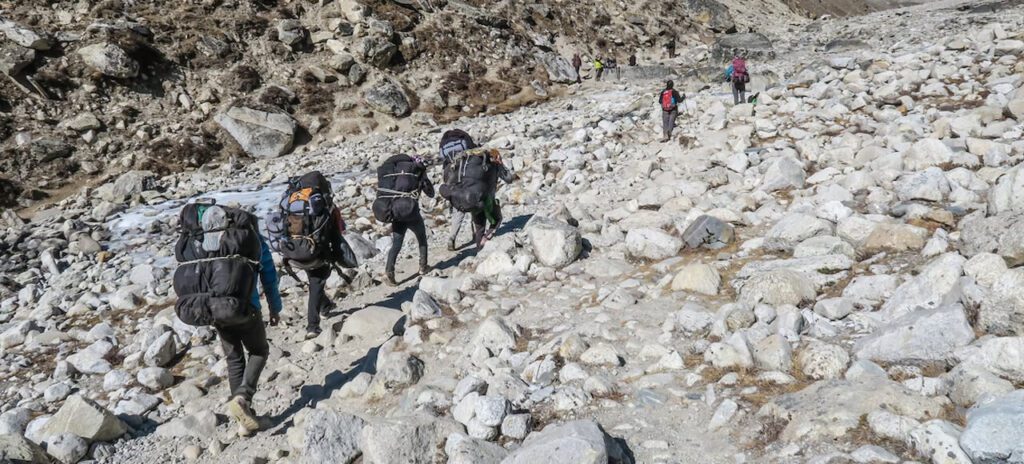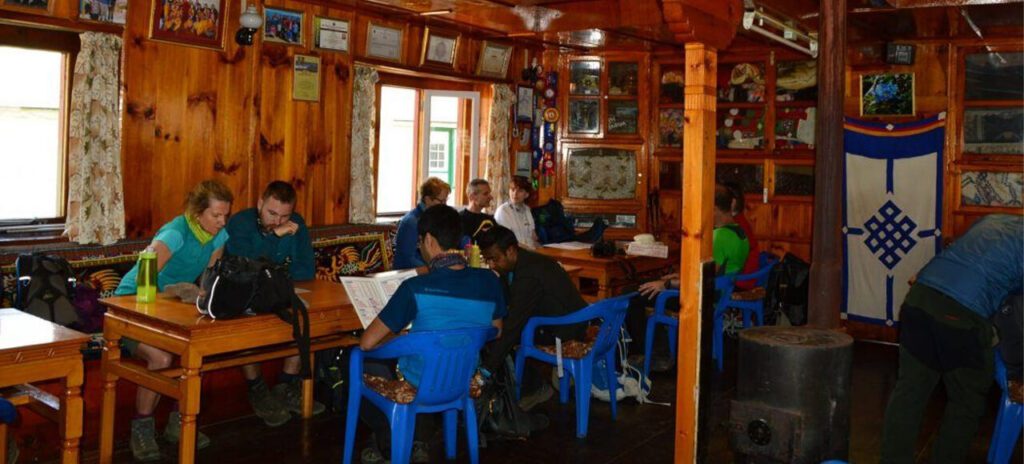Local lifestyle at the Everest Base Camp Trek – One of the most famous treks in the world is the Everest Base Camp Trek, which attracts thousands of hikers each year. The trek provides an opportunity to experience local culture and lifestyle in addition to an amazing adventure with beautiful views. The Sherpa people come from Nepal’s Himalayan area and are distinguished by their distinctive culture and mountaineering ability. In this blog post, we will look at the Sherpa culture and their local way of life at the Everest Base Camp trek area.
The Local Lifestyle at the Everest Base Camp Trek
The Everest Base Camp Trek is a challenging trek, and the native way of life is as rugged as the area. Many little communities, each with a distinctive culture and way of life, are passed through on the walk. The settlements give visitors a view of the area’s native way of life. The Sherpa people of the villages are known for their kindness and hospitality to hikers.

The villages along the trek route are self-sufficient, and the locals grow their own food and rearing livestock. The diet of the locals is simple, consisting mainly of rice, dal (lentils), and vegetables. Meat is a more special delicacy, and most of the meat consumed is yak and chicken.
The region’s people are also deeply religious and follow a blend of Buddhism and Hinduism. By visiting the several monasteries and stupas along the trip route, hikers can witness this for themselves as well. The locals believe that the mountains are sacred, and they hold great reverence for them.
Sherpa Culture is one of the Local lifestyle at the Everest Base Camp Trek
Sherpa people have a unique culture shaped by the Himalayan region’s rocky terrain and harsh weather conditions. They are known for their mountaineering skills and have assisted mountaineers in their expeditions to the world’s highest peak Mount Everest many times.
The Sherpas have a deep respect for their ancestors and elders and follow a traditional lifestyle. The language they speak is called Sherpa which is a dialect of Tibetan. The Sherpa people also have their own way of dressing, this way of dressing consists of a long-sleeved shirt, trousers, and a woolen jacket, which is called a “Bakkhu.”

One of the most impressive and recognizable cultural events of the Sherpas is the Mani Rimdu festival. This festival lasts for 10 days and takes place at the Tengboche Monastery, one of the most important monasteries in the area. The festival is a celebration of the victory of Buddhism over Bon, an ancient religion of Tibet.
Sherpas are known for their hospitality, and they are always willing to welcome trekkers into their homes. Moreover, a nice way for trekkers to experience the Sherpa way of life is by staying in a teahouse, which is a traditional Sherpa guest house. In these teahouses, trekkers can find basic accommodation and food. Despite the lack of luxury, the warmth and friendliness of the Sherpa people more than make up for it.
Sherpa Culture and Lifestyle
The Sherpa people are an ethnic group who live in the high areas of the Himalayan region, primarily in Nepal. Their culture, shaped by their environment and their close relationship with the mountains, is very unique. As mentioned before, Sherpas possess mountaineering skills and have therefore played a crucial role in many successful Everest expeditions.
Also Read: Everest Base Camp Route – From Tenzing Hillary route to Heli ride
Sherpa Lifestyle
The Sherpa lifestyle is a simple and sustainable way of living, they have a deep respect for nature and the environment. Sherpa people are known for their hard work and resilience to harsh weather conditions. They mainly live in villages and depend on agriculture and the keeping of animals for their livelihood.
Dress
Sherpa people have a special way of dressing that is based on the environment they live in. This dress code consists of long-sleeved shirts, trousers, and woolen jackets known as “Bakkhus”. The Bakkhu is a traditional Sherpa piece of clothing made of wool or yak hair. It is specially designed to keep the body warm even in the weather conditions of the Himalayas.
You may also like: Clothing for the Everest Base Camp Trek: A Comprehensive Guide
Religion
The Sherpa people have deep religious roots that they still live for, they follow a religious mix of Buddhism and the ancient Bon religion. They believe in the existence of gods and spirits and hold great admiration for the mountains and nature. The Tengboche Monastery is one of the most important monasteries in the Everest region and is a center of the Sherpa’s religious and cultural life.
Festivals
The Sherpa people celebrate many festivals throughout the year, with the most important being the Mani Rimdu festival. The festival is a ten-day celebration in the Tengboche Monastery. It is a celebration of the victory of Buddhism over the ancient Bon religion. The festival has masked religious dances, prayers, and other rituals. It is a highlight in the Sherpa cultural calendar, I truly experience being around.
Agriculture is also part of the Local lifestyle at the Everest Base Camp Trek
Agriculture is the main occupation of the Sherpa people; it is a big part of their lifestyle. They grow many different types of plants, like potatoes, barley, and buckwheat, these plants can withstand cold and harsh weather conditions of the Himalayas. The Sherpas also grow vegetables like spinach, cauliflower, and carrots. They use traditional methods of farming, which rely on oxen or yaks for plowing the fields.
Animal farming
Sherpas are known for their knowledge of animal keeping, in particular farming yaks. Yaks are used to living in the harsh environment of the Himalayas they are used for transportation and for their milk, meat, and wool.

Furthermore, they also keep goats, sheep, and chickens.
Hospitality
The Sherpa people are known for their hospitality and always welcome visitors with warmth and generosity. Trekkers can experience the Sherpa way of life by staying in teahouses, which are traditional Sherpa guesthouses. The teahouses offer basic accommodation and food, but the warmth and friendliness of the Sherpa people make up for the lack of luxury.

Food
Food is an integral part of any culture, and Sherpa cuisine is no exception. Sherpa food is known for its hearty and filling nature, as it needs to provide sustenance for people living in high-altitude areas with harsh weather conditions.
Staple Foods:
The Sherpa diet consists mainly of rice, lentils, potatoes, and vegetables. These staple foods provide all the energy and nourishment that is needed. It also helps to combat cold temperatures at high altitudes. In addition to these staple foods, the Sherpas also eat meat occasionally and dairy products from their yaks, goats, and sheep.
Traditional Dishes:
A popular Sherpa dish is “Thukpa,” a soup made with noodles, vegetables, and meat. Another popular dish is “momos,” which are dumplings filled with meat or vegetables and can be prepared steamed or fried.

Lastly “Dal Bhat” is an everyday dish, consisting of lentil soup, rice, and vegetables. A staple drink is “Chhang”, this is a fermented drink made from barley, and it is a popular beverage in the region.
Sherpa Tea:
“Chiya,”, also called Sherpa tea, is a common local beverage in the region. The tea is made by boiling water with tea leaves, milk, and sugar in it. Most times they drink it together with snacks like biscuits or roasted corn.
Sherpa Snacks:
The Sherpas have several snacks that are popular in the region. One of them is “tsampa,” a roasted barley flour that is mixed with water to make a porridge-like dish. Another snack is “Phapar,” which is made by roasting and pounding rice into flour and mixing it with yak butter and sugar.
Sherpa Cuisine on the Everest Base Camp Trek:
During the Everest Base Camp trek, trekkers can experience Sherpa cuisine at the teahouses along the route. These teahouses offer basic accommodation and food, but the Sherpa hospitality and warmth make up for the lack of luxury. Sherpa cuisine is often served in generous portions, providing trekkers with the energy and nourishment they need for the challenging trek.
Conclusion
The Everest Base Camp Trek is a challenging but rewarding trek that gives you an insight into the local lifestyle and Sherpa culture. The Sherpa people are an essential part of the trek and overall experience. The local’s hospitality and deep respect for nature make them fascinating people to live with.
The Sherpa culture is unique and is shaped by the harsh terrain and weather conditions of the Himalayan region. The Mani Rimdu festival is a highlight of the Sherpa cultural calendar. It is a must-see for everyone interested in experiencing the Sherpa way of life. If The Everest Base Camp Trek is not on your bucket list already, I hope you’re convinced now, to visit this beautiful area with beautiful people.
Let our expert team at Asian Heritage Treks and Travel take care of everything — from guided tours to personalized packing tips and travel arrangements.
Plan My Everest Trip







